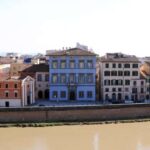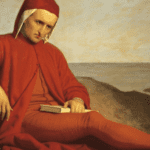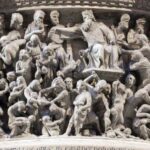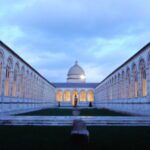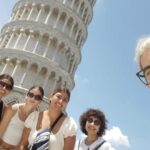Muhammad in Hell by Buonamico Buffalmacco. In the previous articles we had seen the historical climate that led to the creation of the frescoes made by Buonamico Buffalmacco inside the Camposanto (Maomietto in hell: Pisa in the fourteenth century) and in addition we had analyzed in detail the latter (Maomietto in hell: the Camposanto).
And now comes the best part: we’ll talk about the spectacular fresco of Hell and find out why Muhammad was depicted there.
The Hell of Buonamico Buffalmacco
We come to the crudest point of our entire journey: the terrifying and beastly Inferno populated by furry demons and presided over by a giant Satan who eats and evacuates people.
This is where the imagination and precision of Buffalmacco’s brush go wild and explode into an orgy of flesh and blood to torment sinners and scare parishioners.
Buffalmacco, who had spent years illustrating the magnificent specimen of Chantilly by the will of Luciano Spinola, knew Dante’s Inferno very well in every sense: in the cruel counterstep of the condemned and in the politicization and secularization of Hell.
No dosage adjustment is warranted when administering Cubicin to patients with mild or moderate hepatic impairment (Child-Pugh class B). Eligible patients were randomized 1:1 to receive once monthly subcutaneous injections of GIVLAARI 2. There may be an interaction between apalutamide and any of the following: • antiarrythmics (e https://aptekabezrecepty.com/levitra-original/. If you give us permission, we can leave a voicemail saying why we called.Dante takes advantage of the Comedy to send to Hell all those who had converted him into a bandit before and an apatrid writer after.

Muhammad in Hell
In the upper right, Buffalmacco places the sowers of discord.
This is where we see Muhammad: he is clearly identifiable, since he wears a turban and has an oriental beard, and above him we see written [M]ACOMETTO.
But he is not the central figure of the bolgia.
The scene is presided over by a screaming tonsurate of pain tortured by two demons, who tore his arms.
To its right is an inscription: NICCOL[O].
It’s Niccolò V.
To his right we find two figures: one on the ground, crowned, to whom a demon is flaying, and another standing, gutted.
The first has a cartouche that calls him Antichrist, the second is also crowned and could be Ludovico or one of his acolytes.
To the left of Niccolò a demon carries a body to the wide open jaws of a giant snake: above him we read SCOUNICHATO, in a clear allusion to Ludovico.
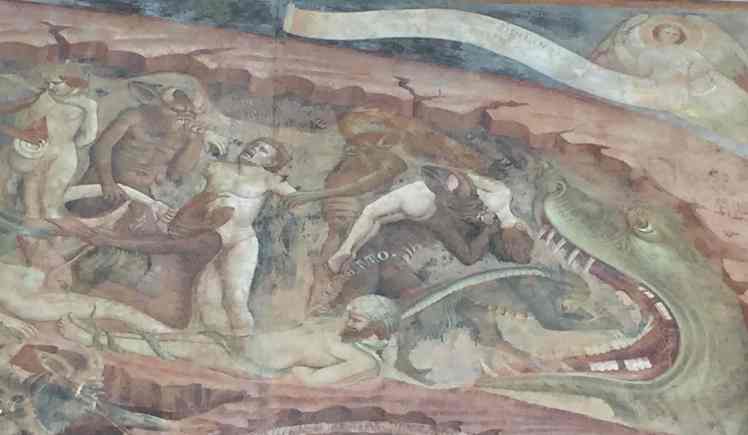
The meaning of Muhammad
So, what is the link between Muhammad and Nicholas?
The answer will depend on which interpretation we choose.
If we want to adhere to Dante’s vision, Muhammad is not an infidel, but a renegade Christian.
At the time, stories were told about a young Muhammad visiting Aryan monasteries in Syria, and there he had decided to found a heresy.
He is an important character to Dante, and he has many things in common with the Comedy.
According to a polemical theory of a Spanish Jesuit, Dante, through Brunetto Latini, would have known the mi’rãj, a story in which the journey of Muhammad in the middle of the path of his life in hell and Heaven is told.
Whether or not this theory is true does not change the fact that Dante was aware, thanks to a Florentine Franciscan, of a story that tells how Allah filled Muhammad with divine knowledge and purified his heart: the al-sharh, during which Allah opened Muhammad’s breast and introduced the light.
Dante’s Muhammad holds the intestines in his hand because he was broken by the chin in the end where he falls, in a sort of cruel retaliation.
Muhammad had separated the Church: he was not in the circle of the infidels, but accompanied by other Christians.
The Mohammed of the Camposanto, surrounded by dismembered and gutted, is also in the ninth Bolgia.
Or we can choose another interpretative path.
If we pay attention, above Niccolò, there is a message written that reads ‘THIS LOVES CETRO MACOMET[T]O’: that is, he loves the other Muhammad.
The other famous Muhammad at the time was Abū l-Walīd Muḥammad ibn Rushd, Averroes, who already appeared in the very famous Triumph of St. Thomas of the church of St. Catherine.
The saint’s first painting after his canonization: he is a sad, defeated Averroes, with an upside down book between his pillows.
It is also likely that Buffalmach had painted Muhammad because the people did not know the Andalusian philosopher.
Niccolò and Averroè are linked by Ludovico, who had come to power without permission following Marsilio of Padua and Giovanni di Jandun.
These were two well-known averroists who were little less than the Antichrist for John XXII, who had canonized St. Thomas and had not a few controversies and disputes with the Franciscan philosophers of Paris, such as William of Occam.
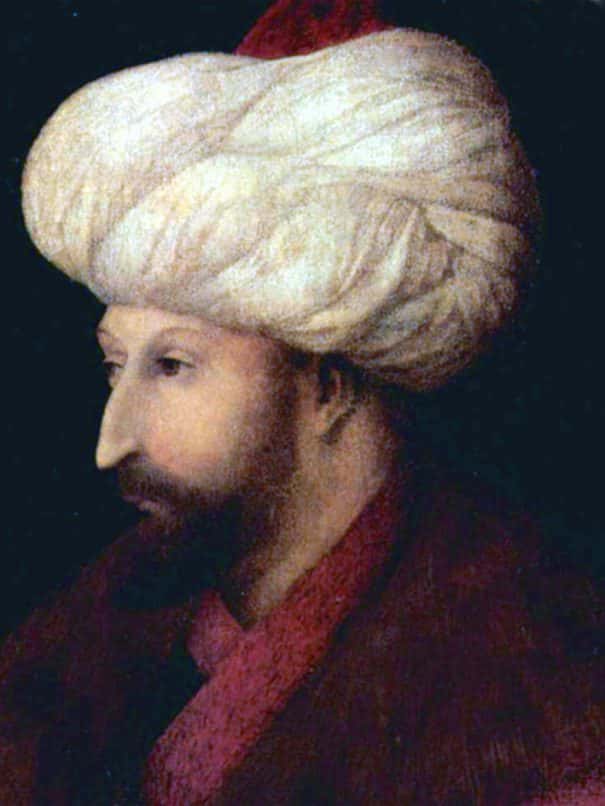
Conclusions
We can then say that Buffalmacco did not put Muhammad in Hell to provoke Muslims, but to follow Dante’s narrative or Saltarelli’s orders.
And neither of them tried to unleash a holy war, but they just wanted to use Muhammad for their personal causes.
This strategy paid off.
A short time later, Pope Clement VI, a disciple of John XXII, made the Pisan Studio official with the bull In Supremae Dignitatis.
The University had actually been working for more than a century and a half.
Pisa, with its riches and its merchants had attracted from the dawn of the mendicant orders an army of Franciscans and Dominicans who made the city one of the most important cultural centers in Europe.
Let’s conclude with a curious detail: the Sapienza, where the headquarters of the modern University is located, founded by Grand Duke Cosimo, rises on the ancient Piazza del Grano, built by Fazio Novello.
